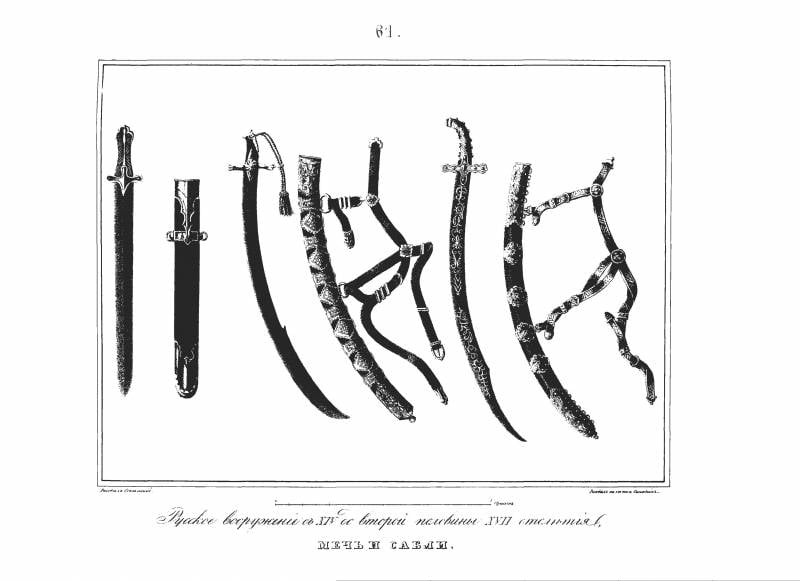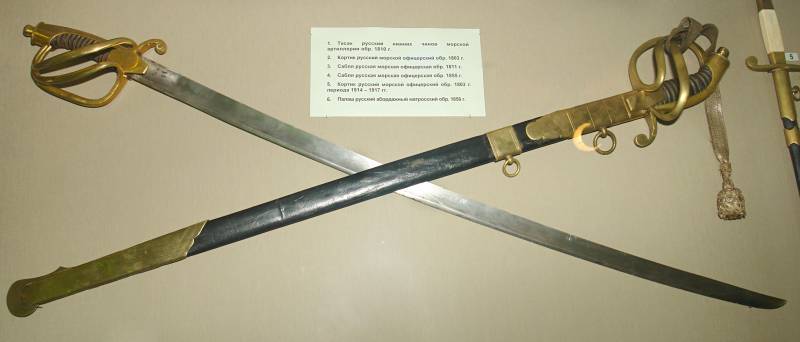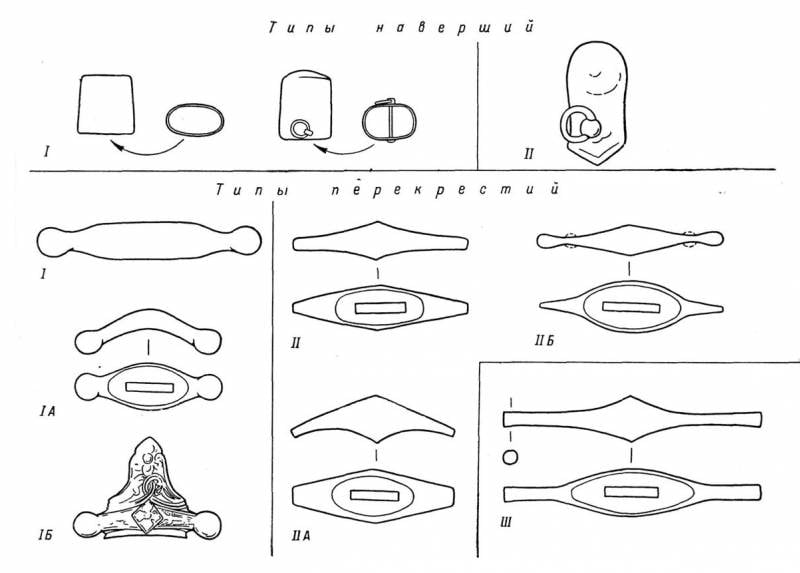Old Russian saber: weapons with a reserve for modernization

Saber of the X century from the collection of the State Historical Museum. According to the customs of that time, before putting into burial the saber was bent and spoiled. Wikimedia Commons Photos
In service with the Russian warriors there was a diverse blade weapon. The sabers of various kinds remained the longest in service. The first such samples in the Old Russian army date back to the 10th century, and the full use of the saber continued almost until the beginning of the 20th century. Thus, the saber turned out to be the most enduring type of cold steel in our army. The main features of the sabers, laid more than a thousand years ago, turned out to be useful even later.
Weapons from the steppes
It is known that the first versions of the saber appeared in the VII-VIII centuries. and quickly spread throughout much of Eurasia. Due to a number of characteristic features, the saber was a convenient weapon for an equestrian warrior, which contributed to its rapid spread in different regions. In the future, similar weapons appeared among the Eastern Slavs.
Ancient Russia met with a saber in the IX-X centuries. in connection with the raids of nomads. The first to recognize such weapons were the principalities in the South and Southeast, who took upon themselves the main blow. The Old Russian army followed foreign innovations and tried to adopt the best ideas and best practices. The same thing happened with the saber, however, it was far from immediately possible to reveal its potential.
At the turn of two millennia in Russian rati, two new weapons appeared at once - a sword and a saber. The sword quickly took a dominant position and became the main blade weapon. Over the next several centuries, the saber was inferior to him in terms of distribution and mainly remained a specialized weapon.
It is curious that in the first period the saber was not only a weapon of a warrior, but also a status item. It is to this period that several interesting finds relate. In a number of burials, sabers with skillful decoration were discovered, showing the status and position of the owner in society.
In the XI-XII centuries. there is an increase in the number of sabers, and at the same time, an increase in their share in rati. New technologies were mastered, which allowed to increase output. In parallel, saber propagation is observed. If earlier they were used only in the southern principalities, then from the XI century. reach Minsk and Novgorod.
Design features
Sabers of Ancient Russia almost did not differ in design from similar weapons of other countries. The development of the design was carried out in approximately the same way as abroad. Over time, the shape and size of the blade changed, and in parallel the hilt improved.

Sword and sabers of different kinds. Illustration from the book of A.V. Viskovatova "Historical description of clothing and weapons of the Russian troops "
The earliest Old Russian sabers had a single-blade blade about 1 m long, about 3-4 cm wide, with a slight bend. By the XII century. the blade became longer by 10-15 cm and became slightly wider. The bend also increased and the mass increased. Thus, later sabers differed from their predecessors in a greater force of chopping impact, as well as higher cutting rates. These trends continued in the future, which in the future led to the appearance of even more curved sabers.
The early Old Russian sabers, mostly richly finished, were distinguished by the relative complexity of production. During the forging, welding of iron and steel plates was carried out, and the finished blade was decorated with copper or gold wire. Later, as the saber spread, simpler technologies were used. Iron sabers with a welded steel blade or cemented whole-iron specimens were found. Naturally, such sabers were not decorated in any way.
The hilt was changing quite actively. There are several basic types of guards and tops, characteristic of different periods and regions. Initially, in Russia there were direct guards with balls at the ends, also found in other countries. Subsequently, the shape of these products changed. The thickenings disappeared, the ends lengthened and bent for greater ease of cutting and additional protection of the hand.

Other sabers from different eras. Illustration from the book of A.V. Viskovatova "Historical description of clothing and weapons of the Russian troops"
Hiking and horseback riding
Due to the correct ratio of length, width and bending, the saber has a combined cutting-cutting action. The double-edged end also allows injections. Thanks to such qualities, the saber can be used by an infantryman or a horseman. In some situations, it has advantages over a sword with a straight double-edged blade.
According to known data, the mass distribution of sabers in Russia was associated with the development of cavalry. It was the riders who were the main users of sabers, as evidenced by archaeological finds. Sabers were also used in infantry, but in smaller quantities and only in certain regions.
An old Russian saber was developed and used with the sword, and these two weapons could compete with each other. However, this problem was solved in the most successful way. In the infantry of most principalities, the sword remained the main blade weapon, and the saber was not able to noticeably squeeze it. The reverse processes were observed in the cavalry: first in the southern regions, and then onwards the saber began to supplant the sword.

Saber attributed to Vladimir Monomakh. In fact - a product of the XVII century. Illustration from the collection "Antiquities of the Russian State"
Despite such processes, for several centuries the sword and saber remained the equal arms of warriors. There were no reasons for the disappearance of one sample and the greater spread of another. First of all, this was due to the specifics of the military-political situation. Opponents of Ancient Rus were simultaneously heavily armed European warriors and highly mobile nomadic horsemen. To combat them effectively, different means were required, which affected the arms of the Russian rati in different regions.
Great future
Similar approaches to arming warriors persisted over the next several centuries. However, in the XIV century. new processes began, the result of which was a change in the rati weapons complex. The development of armies and tactics led to a gradual reduction in the role of swords and an increase in the proportion of sabers. In addition, the new sabers kind of resembled swords and could show similar characteristics.
As a result, by the XV-XVI centuries. in the Russian army, a saber almost completely supplanted the sword. In addition, new samples of blade weapons with various features appeared. New types of sabers, adapted to solving different problems, were created independently or borrowed from foreigners. In later periods, the saber remained one of the main armaments of archers, local cavalry, Cossacks, regiments of a foreign system, etc.

Sabers of Minin and Pozharsky, XVI-XVII centuries. Illustration from the collection "Antiquities of the Russian State"
The development of sabers went by changing the shape and size of the blade, as well as by finalizing the hilt. Crucial were the technology of metal smelting and forging of finished products. The formation of the fencing school allowed us to more fully reveal the potential of weapons.
The great value of the saber was preserved in modern times. New types of such weapons were developed and introduced, including intended for specific military branches. The saber retained the status of the main cold steel of the Russian army until the end of the 19th century, when the mass introduction of drafts began. However, this did not lead to its early disappearance.
Ten centuries of development
The first sabers of Ancient Russia discovered belong to the X century. However, in fact, such weapons could appear a little earlier. Later sabers remained in service until the XX century. Thus, edged weapons with a curved blade and one-sided sharpening have been relevant for a thousand years, which can be considered a real record.

Naval officer sabers of the XIX century. Left - arr. 1855, on the right - arr. 1811 g. Photo by Wikimedia Commons
The reasons for such results should be sought in the successful concept and design of the blade. The saber is capable of striking and chopping (with a cutting action) blows, and is also relatively simple to manufacture and use. Through various changes of the blade and hilt, the saber can be modified to meet specific requirements, which has repeatedly happened in the past.
For several centuries, gunsmiths used the full potential of the saber, which led to well-known results. At first, this weapon was able to gain a foothold in Old Russian rati and in some areas to squeeze the sword, and then completely replace it. After this, the saber remained one of the main weapons for several centuries. Not all types of knives can boast of such survivability.

Information